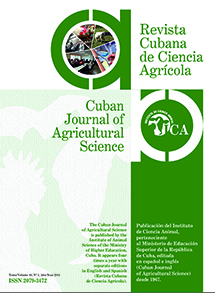Multi-trait selection in Holstein cows
Contenido principal del artículo
Resumen
The phenotypic and genealogical data of 1 571 Holstein cows located in three livestock enterprises during the years 1984 to 2016 were used. The purpose of this study was to carry out the multi-trait selection of dairy production, reproduction and longevity traits by means of the preparation of selection indexes (SI) through the analysis of main components (MC). Correlations and breeding values (BV) were estimated for the traits: cumulative milk production up to 305 days (BVL305), duration of lactation
(BVDL), age at first parturition (BVAP1), gestation parturition interval (BVGPI), accumulated milk per life (BVTML) and productive life (BVPL) by means of a multi-trait animal model. The SPSS statistical package was used to perform the MC analysis, for which the BV were standardized, and the Kaiser criterion was used to select the MC that explains the greatest genetic variation. The genetic correlations between L305, TML and DL showed mean values (0.55, 0.47 and 0.27), and between GPI and PL of 0.29. The first two main components (MC1, MC2) were those that obtained the Kaiser criterion and explained 53.7 % of the total variance of the BV. Linear correlations between BVs with each main component showed that
L305, DL and TML were related with the MC1, and GPI and PL to MC2. It is concluded that in Holstein cows it is possible to perform multi-trait selection by constructing selection indexes based on the first two MCs, since they showed considerable genetic variation.
Key words: main component analysis, dairy cattle, selection indexes
(BVDL), age at first parturition (BVAP1), gestation parturition interval (BVGPI), accumulated milk per life (BVTML) and productive life (BVPL) by means of a multi-trait animal model. The SPSS statistical package was used to perform the MC analysis, for which the BV were standardized, and the Kaiser criterion was used to select the MC that explains the greatest genetic variation. The genetic correlations between L305, TML and DL showed mean values (0.55, 0.47 and 0.27), and between GPI and PL of 0.29. The first two main components (MC1, MC2) were those that obtained the Kaiser criterion and explained 53.7 % of the total variance of the BV. Linear correlations between BVs with each main component showed that
L305, DL and TML were related with the MC1, and GPI and PL to MC2. It is concluded that in Holstein cows it is possible to perform multi-trait selection by constructing selection indexes based on the first two MCs, since they showed considerable genetic variation.
Key words: main component analysis, dairy cattle, selection indexes
Detalles del artículo
Cómo citar
Hernández, A., & Ponce de León, R. (2020). Multi-trait selection in Holstein cows. Cuban Journal of Agricultural Science, 54(4). Recuperado a partir de https://mail.cjascience.com/index.php/CJAS/article/view/994
Sección
Genética
Aquellos autores/as que tengan publicaciones con esta revista, aceptan los términos siguientes:
- Los autores/as conservarán sus derechos de autor y garantizarán a la revista el derecho de primera publicación de su obra, el cuál estará simultáneamente sujeto a la Licencia Creative Commons Attribution-NonCommercial 4.0 International (CC BY-NC 4.0) que permite a terceros compartir la obra siempre que se indique su autor y su primera publicación esta revista. Bajo esta licencia el autor será libre de:
- Compartir — copiar y redistribuir el material en cualquier medio o formato
- Adaptar — remezclar, transformar y crear a partir del material
- El licenciador no puede revocar estas libertades mientras cumpla con los términos de la licencia
Bajo las siguientes condiciones:
- Reconocimiento — Debe reconocer adecuadamente la autoría, proporcionar un enlace a la licencia e indicar si se han realizado cambios. Puede hacerlo de cualquier manera razonable, pero no de una manera que sugiera que tiene el apoyo del licenciador o lo recibe por el uso que hace.
- NoComercial — No puede utilizar el material para una finalidad comercial.
- No hay restricciones adicionales — No puede aplicar términos legales o medidas tecnológicas que legalmente restrinjan realizar aquello que la licencia permite.
- Los autores/as podrán adoptar otros acuerdos de licencia no exclusiva de distribución de la versión de la obra publicada (p. ej.: depositarla en un archivo telemático institucional o publicarla en un volumen monográfico) siempre que se indique la publicación inicial en esta revista.
- Se permite y recomienda a los autores/as difundir su obra a través de Internet (p. ej.: en archivos telemáticos institucionales o en su página web) antes y durante el proceso de envío, lo cual puede producir intercambios interesantes y aumentar las citas de la obra publicada. (Véase El efecto del acceso abierto).
